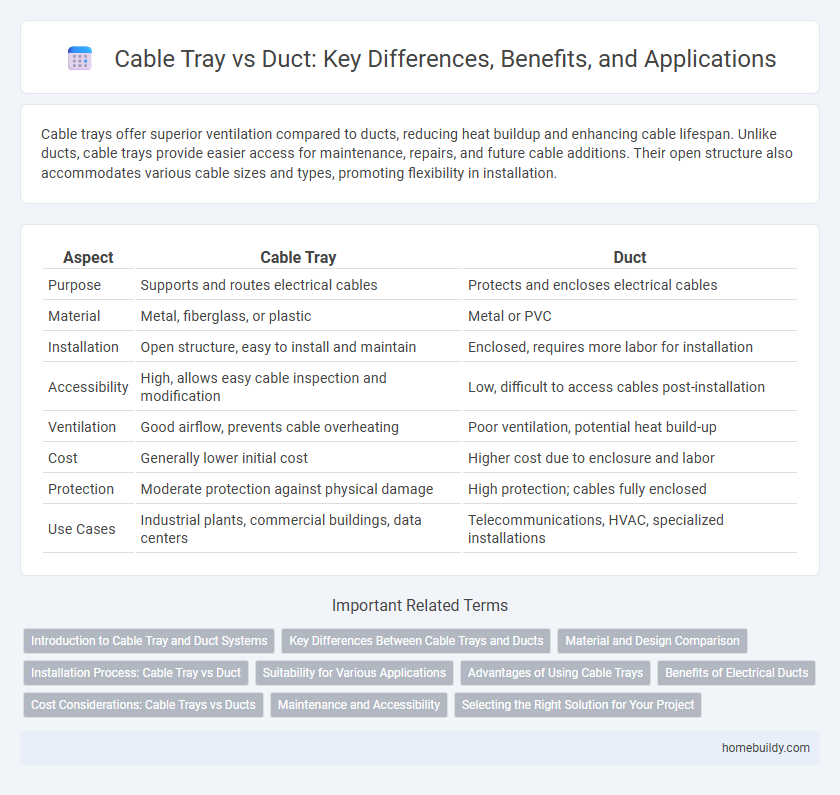Cable trays offer superior ventilation compared to ducts, reducing heat buildup and enhancing cable lifespan. Unlike ducts, cable trays provide easier access for maintenance, repairs, and future cable additions. Their open structure also accommodates various cable sizes and types, promoting flexibility in installation.
Table of Comparison
| Aspect | Cable Tray | Duct |
|---|---|---|
| Purpose | Supports and routes electrical cables | Protects and encloses electrical cables |
| Material | Metal, fiberglass, or plastic | Metal or PVC |
| Installation | Open structure, easy to install and maintain | Enclosed, requires more labor for installation |
| Accessibility | High, allows easy cable inspection and modification | Low, difficult to access cables post-installation |
| Ventilation | Good airflow, prevents cable overheating | Poor ventilation, potential heat build-up |
| Cost | Generally lower initial cost | Higher cost due to enclosure and labor |
| Protection | Moderate protection against physical damage | High protection; cables fully enclosed |
| Use Cases | Industrial plants, commercial buildings, data centers | Telecommunications, HVAC, specialized installations |
Introduction to Cable Tray and Duct Systems
Cable trays provide an open support system for electrical cables, allowing for easy installation, inspection, and maintenance, while duct systems offer enclosed conduits that protect cables from environmental factors and physical damage. Cable trays are typically preferred in industrial settings for their flexibility and ventilation advantages, whereas ducts are ideal in environments requiring higher protection and aesthetic concealment. Understanding the distinct applications of cable trays and ducts ensures optimal cable management based on safety, accessibility, and environmental conditions.
Key Differences Between Cable Trays and Ducts
Cable trays provide an open support system for electrical cables, allowing easy cable installation, ventilation, and heat dissipation, whereas ducts are enclosed conduits that protect cables from environmental factors but limit airflow. Cable trays are typically preferred in industrial and commercial settings for flexibility and maintenance, while ducts are favored in environments requiring enhanced cable protection and fire resistance. The choice between cable trays and ducts depends on factors such as installation cost, cable type, environmental exposure, and safety requirements.
Material and Design Comparison
Cable trays typically feature materials like galvanized steel, aluminum, and stainless steel, offering excellent corrosion resistance and mechanical strength, while ducts are often made from sheet metal or PVC, prioritizing enclosure and protection from environmental factors. The design of cable trays allows for easy cable support, ventilation, and accessibility, facilitating rapid installation and maintenance, whereas ducts provide enclosed pathways that shield cables from dust, moisture, and physical damage but may require more effort for modifications. Material choices impact durability, weight, and cost, with cable trays favoring robustness and flexibility and ducts emphasizing environmental sealing and aesthetics.
Installation Process: Cable Tray vs Duct
Cable tray installation involves simply laying the trays along the designated path and securing them with brackets, allowing for quick and flexible cable management in large-scale electrical systems. Duct installation requires more complex steps, including assembling conduit sections, pulling cables through enclosed spaces, and sealing joints to protect against environmental factors. Cable trays generally reduce labor time and costs compared to ducts, especially in applications requiring frequent cable additions or maintenance.
Suitability for Various Applications
Cable trays are ideal for industrial environments where frequent cable changes and heavy-duty support are required, offering excellent ventilation and easy access for maintenance. Ducts provide better protection in corrosive or dusty environments and are more suitable for applications requiring enhanced security and aesthetics. Choosing between cable trays and ducts depends on specific project needs such as environmental conditions, installation complexity, and cable management flexibility.
Advantages of Using Cable Trays
Cable trays offer superior ventilation compared to ducts, preventing overheating of electrical cables and reducing fire hazards. They provide easier access for installation, maintenance, and future cable upgrades, significantly cutting labor costs. The modular design of cable trays allows for flexible routing and quick modifications, enhancing overall project efficiency.
Benefits of Electrical Ducts
Electrical ducts offer superior protection against environmental factors such as moisture, dust, and physical damage compared to cable trays, ensuring enhanced longevity and reliability of electrical wiring. They provide a more secure and enclosed pathway, reducing the risk of accidental contact and improving overall safety in industrial and commercial settings. Additionally, ducts facilitate better organization and easier future cable additions or replacements due to their modular and accessible design.
Cost Considerations: Cable Trays vs Ducts
Cable trays generally offer a more cost-effective solution compared to ducts due to lower material and installation costs. Cable trays require less labor-intensive installation and provide easier access for future cable additions or maintenance, reducing long-term expenses. In contrast, ducts often involve higher initial investment and increased complexity in upgrades, making trays preferable for budget-conscious projects.
Maintenance and Accessibility
Cable trays offer superior maintenance and accessibility compared to ducts, allowing easy inspection, repair, and cable management without dismantling the entire system. Unlike ducts, cable trays provide open pathways that significantly reduce downtime during troubleshooting or upgrades. This open design enhances airflow around cables, preventing overheating and extending cable lifespan, which is critical for efficient facility operations.
Selecting the Right Solution for Your Project
Choosing between cable trays and ducts depends on factors such as ventilation, cable type, and installation environment. Cable trays offer superior airflow, making them ideal for power and fiber optic cables requiring heat dissipation. Ducts provide enhanced protection against dust and moisture, suitable for sensitive communication cables in harsh conditions.
Cable tray vs duct Infographic

 homebuildy.com
homebuildy.com